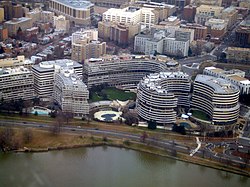James W. McCord Jr.
James W. McCord Jr. | |
|---|---|
| Born | James Walter McCord Jr. June 26, 1924 Waurika, Oklahoma, U.S. |
| Other names | Ed Martin[1] |
| Alma mater | University of Texas at Austin George Washington University |
| Occupation(s) | former CIA officer and electronics expert |
| Known for | Participation in the Watergate Scandal |
| Military career | |
| Service/ | United States Air Force Reserve |
| Rank | Lieutenant colonel |
| Watergate scandal |
|---|
 |
| Events |
| People |
James Walter McCord Jr. (born June 26, 1924) is a former CIA officer, later involved, as an electronics expert, in the burglaries which precipitated the Watergate scandal.[2]
Career
McCord was born in Waurika, Oklahoma[3][4] and briefly attended Baylor University before receiving a B.B.A. from the University of Texas at Austin in 1949.[5] In 1965, he received an M.S. in international affairs from George Washington University.[6][5] After beginning his career at the Federal Bureau of Investigation (FBI), McCord worked for the Central Intelligence Agency (CIA), ultimately ascending to a GS-15 position in the Agency's Office of Security.[7] For a period of time, he was in charge of physical security at the Agency's Langley headquarters.[8] According to Russ Baker, then-Director of Central Intelligence Allen Dulles once introduced McCord to an Air Force colonel as "the best man we have".[9] In 1961, and under his direction, a counter-intelligence program was launched against the Fair Play for Cuba Committee.[10] He also held the rank of lieutenant colonel in the United States Air Force Reserve.[11]
Watergate
Shortly after resigning from the CIA, McCord was interviewed and then hired by Jack Caulfield in January 1972 "for strict, solely defensive security work at the Republican National Committee and the Committee to Re-Elect the President (CRP)". He and four other accomplices were arrested during the second break-in to the Democratic National Committee's headquarters at the Watergate complex on June 17, 1972. The arrests led to the Watergate scandal and resignation of President Nixon. McCord was one of the first men convicted in the Watergate criminal trial; on eight counts of conspiracy, burglary and wiretapping.[3] In a later letter, written to U.S. District Judge John Sirica, McCord stated that his plea and testimony, some of which he claimed was perjured, were compelled by pressure from White House counsel John Dean and former Attorney General John N. Mitchell. The letter implicated senior individuals in the Richard Nixon administration of covering up the conspiracy that led to the burglary.[12]
Notes
- ^ Dean, John (1976). Blind Ambition: The White House Years. New York, New York: Simon and Schuster. p. 90. ISBN 0671224387.
- ^ Gerald Gold, ed. (1973). The Watergate hearings: break-in and cover-up; proceedings. New York: Viking Press. p. 147. ISBN 0-670-75152-9. OCLC 865966.
- ^ a b Dickinson, William B.; Mercer Cross; Barry Polsky (1973). Watergate: chronology of a crisis. Vol. 1. Washington D. C.: Congressional Quarterly Inc. p. 40. ISBN 0-87187-059-2. OCLC 20974031. This book is volume 1 of a two volume set. Both volumes share the same ISBN and Library of Congress call number, E859 .C62 1973
- ^
Dash, Samuel, Mads (1976). Chief counsel: inside the Ervin Committee--the untold story of Watergate. New York: Random House. p. 59. ISBN 0-394-40853-5.
{{cite book}}: CS1 maint: multiple names: authors list (link) - ^ a b Hearings Before and Special Reports Made by Committee on Armed Services of the House of Representatives on Subjects Affecting the Naval and Military Establishments. U.S. Government Printing Office. 1975.
- ^ The Michigan Journal. University of Michigan-Dearborn. 1974.
- ^ Edmund Callis Berkeley (1972). Computers and Automation. Edmund C. Berkeley and Associates.
- ^ Stafford T. Thomas (1 January 1983). The U.S. Intelligence Community. University Press of America. ISBN 978-0-8191-3098-3.
- ^ https://whowhatwhy.org/2017/06/29/watergate-downing-nixon-part-3/
- ^ Oswald and the CIA by John Newman page 138.
- ^ United States. Congress. House. Government Operations (1972). U.S. Government Information Policies and Practices--problems of Congress in Obtaining Information from the Executive Branch: Hearings Before a Subcommittee. U.S. Government Printing Office.
- ^ Dash, Samuel, Mads (1976). Chief counsel: inside the Ervin Committee--the untold story of Watergate. New York: Random House. p. 30. ISBN 0-394-40853-5.
When Judge Sirica finished reading the letter, the courtroom exploded with excitement and reporters ran to the rear entrance to phone their newspapers. The bailiff kept banging for silence. It was a stunning development, exactly what I had been waiting for. Perjury at the trial. The involvement of others. It looked as if Watergate was about to break wide open.
{{cite book}}: CS1 maint: multiple names: authors list (link)
See also
References
- Perlstein, Rick (2008). Nixonland: The Rise of a President and the Fracturing of America. Simon and Schuster. pp. 655, 666–67, 676–80, 683–84, 722. ISBN 978-0-7432-4302-5.
Further reading
McCord wrote a book about his connection with the Watergate burglary:
- McCord, James W. (1974). A piece of tape; the Watergate story: fact and fiction. [Rockville, Md.]: Washington Media Services. ISBN 0-914286-00-5. OCLC 1031449. Retrieved 2007-07-22.
- All the President's Men by Carl Bernstein and Bob Woodward
